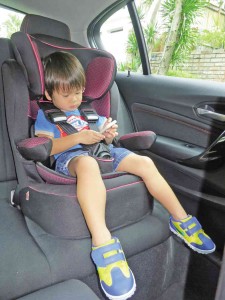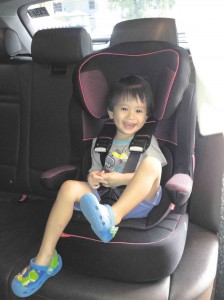
The aftermath of deadly accidents is usually the selling proposition of seatbelts: When you’re buckled up, flying limbs and digits will not make the accident worse.
But the problem is that most of these seatbelts are designed for adults. What about your ever-precious babies? Some of the more common excuses we usually hear are the following: “Your mom or yaya will just wear the seatbelt and hold the baby”, “the baby really cries when placed in the car seat” and “there were no car seats before and you grew up OK!”
Of course, we end up feeling guilty but it’s not too late to change this bad attitude towards something that can save lives, most especially our own.
What we need to know is that several collisions happen during a cash crash. According to a study made by University of Michigan Transportation Research Institute, “the primary impact is between the vehicle and another object, while the occupants continue to travel forward at the precrash speed. Unrestrained occupants then come to an abrupt stop against the decelerating vehicle interior or the ground outside the vehicle. Restrained occupants collide with their belts, or other restraint system, very soon after the primary collision. Finally, there are collisions between the body’s internal organs and the bony structures enclosing them, which can be mitigated by the use of occupant restraint systems.” Now with this data, imagine the effect on an underdeveloped and really soft body of a child. Without the proper restraint, you basically reduce the chances of a kid surviving any vehicular accident to zero every time you place him or her on the lap of the mom or yaya, or alone in the backseat.
Pointers for car seats
Car seats provide an age-appropriate child-restraining system. There are 3 kinds of car seats:
• Birth-12 months
According to Safercar.gov, a rear-facing car seat is the safest because “in a crash, (it) cradles and moves with your child to reduce the stress to the child’s fragile neck and spinal cord.”
•1-6 years old
If your child has reached the headroom limit of his or her rear-facing seat, it’s time to use a forward-facing car seat whose harness limits the forward movement of your child during a crash. Check the manufacturer’s specification on age, weight and height requirements. An ill-fitting car seat is as good as no car seat.
•6-12 years old
What to look for in a car seat
• How long you can use it
Convertible car seats are now available. They can be used from birth to about 2-3 years old depending on the weight and height specifications of the manufacturer. Travel systems come with a base for the car seat (makes car seating hassle-free), the car seat itself and stroller. During your kids’ younger years, these make it easy to transport a sleeping infant. Other front-facing car seats have adjustable height to prolong long use from 1-year-old to about 55 pounds.
• Ease of use
Nothing will age us more than a baby going nuclear just because we cannot slide the seat to recline. Test the car seat in the stores when buying. Sometimes, the features don’t work as
• Materials and technology
Is the fabric breathable? Is it well-padded? Will the five-point harness give your baby some strap burns? Materials are usually the differentiating factor from an expensive and a cheap car seat. According to Maye Yao of Safety First there is such a thing now as side impact Technology, which works like airbags preventing side trauma in an event of a collision.
• Nice to have
When it comes to your child, you should always maintain a safety first policy. Don’t mind people saying you are overprotective or that car seats are a luxury. There are many car seat options available depending on your budget plus the numerous 0-percent-interest installments in the stores. If you can afford a car, then buying a car seat should be one of your must-have accessories.


